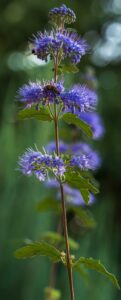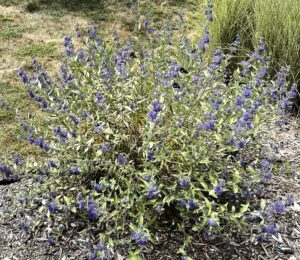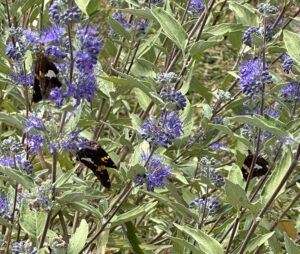Blue Mist Spirea or Bluebeard (Caryopteris x clandonensis)

– Light: Full to part sun. Prefers full sun. The less sun, the less this plant will bloom. I have four in my garden. Two are in full, unrelenting sun and bloom profusely. The other two are in full morning sun for about 6 hours, then shaded the rest of the day. They bloom well, but not as well as the two in full sun. Light will make a difference.
– Soil and water: Grows well in average garden soil with average amounts of rainfall. Once established, it will tolerate some drought. What it will not tolerate is heavy clay soil that has poor drainage.
– Hardiness Zone: 5-9.

– Size. 2-4 feet tall and wide. The four that I have in my garden are about 3 feet tall and wide. Their growth habit is rounded. From a distance, they will have spherical shapes. These are not dense shrubs.
– Bloom period and color. Deadheading: There are several hybrids and all bloom in shades of blue. Some shades are darker than others. The flowers are medium-sized and feathery. They will often stack themselves on the stem like you see in the photo above. The four that I have are ‘Longwood Blue’ which is my favorite. I love that shade of blue – but this is a personal preference. It may also be that as I am from southeastern Pennsylvania and Longwood Gardens has, and always will be, one of my favorite places – it is where I got a lot of my training as a horticulturist. This hybrid was developed at Longwood Gardens and it could be that I am partial to it because of that. Regardless, this is one of my most favorite plants and I have had it in every garden I have ever had.
Although this plant is woody so it is classified as a shrub, treat it as a perennial. Cut it down in early spring – never in the fall. If you cut it back in the fall, it does not winter over as well and you might lose it. I cut mine back around March 20-22 – what a wonderful way to usher in spring! Cut them to within 4-6 inches of the ground. They will take some weeks to get started, but once they do, they grow well and fairly fast and you will have a full-grown shrub by mid-June – often earlier. This plant blooms on new wood and that is what you are creating – all new wood. Your plant will be covered with blooms in August through September.

Insects, butterflies, birds?: The Blue Mist Spirea is a butterfly magnet. When it is in bloom and the day is sunny, if there are butterflies in your area, it will be a rare hour that there are not several to more than a dozen on your plant. Bumblebees and native bees also relish these flowers. I think the activity on and around each blooming plant is astonishing!
Birds who spend the winter in your yard will eat the seeds: sparrows, juncos, finches. This is another reason not to deadhead them in the fall.
Deer, rabbits and other pests: In my experience, deer and rabbits do not like this plant. Neither do aphids and Japanese beetles. I have never had any pests or disease bother any of my plants.
Propagating and transplanting: Seed can be collected in fall after the plants are finished blooming. These seeds need a cold stratification period of about 90 days, but after that, often germinate well. Just be aware since these plants are almost all hybrids, the shrub you get may not be the same as the shrub you have – it could revert back to one of its parents. However, almost all Caryopteris bloom in a shade of blue (a few are white), all are spherically shaped, all are about 3-4 feet tall, and all attract butterflies. You can also take cuttings from new growth on the plant in May. I always use a rooting powder, and I have had success in getting most to root fairly easily. It is possible these cuttings will bloom the first year, but do not count on that. They will bloom in their second year.
I have always had several Blue Mist Spireas in every garden I have ever had, and I have never had one self-seed. Your experience could be different.
Transplanting is easiest in its first and second year. After that, it can be done, but you will need a sharp shovel and the ability to dig deeply. Try not to damage the roots. If you are not an organic gardener, using a transplant solution will help the plant recover from transplanting. You can buy this at any garden center. Just follow the directions on the bottle. I make an effort to be organic as much as I can, but I do make an exception when transplanting shrubs. I always use a transplant solution when moving shrubs and have had excellent success.
Pest and disease. In my experience, deer and rabbits do not bother these small shrubs. And I have never had trouble with any insect damage or disease. These have always been excellent growers for me and have thrived in every garden I have had.
There is nothing about Blue Mist Spirea that I do not like. Besides the lovely shape, the low maintenance, and the pretty flowers at a time when so many other flowers are finished blooming for the season, this plant has fragrant leaves. If you rub them between your fingers, they release a delicious spicy fragrance. My guess is that may be why deer, rabbits, and insects do not munch on them.
What to plant with Blue Mist Spirea: Any of the late-summer and fall blooming plants go well with them: asters and chrysanthemums. One that is not as easy to find, but worth the effort to locate is Montauk Daisy (Nippoanthemum). Just keep in mind if you live on the east coast – particularly in New York, this plant has escaped gardens and has naturalized. The experts do not consider it invasive as – so far – it has not interfered with any native flora anywhere. However, that could change. But as of now, feel free to plant this in your garden. To keep it from escaping your garden, deadhead the fading flowers so seed heads do not form.
How to use this plant: This is a well-behaved small shrub. I use 2 of these plants as foundation plantings in the front of my house. They camouflage the foundation, and their height is up past the bottom of the siding. They also fit very well below the windows without any pruning whatsoever. In winter, their bare branches and twigs look like all the other smaller shrubs. The only time they do not do their job of softening and camouflaging the foundation is in early spring when I cut them down to within 4-6 inches of the ground. However, in April, they will start putting out their silvery/bluish green leaves, the branches will start to grow and by mid-June or earlier, they are back to their full height of 3 about feet. The about 6-8 weeks of bareness is a small price to pay for this lovely shrub and its wonderful bloom!
These shrubs can be used to soften or camouflage anything: garage, shed, a wall, a fence. They can also be used as a short hedge between properties or to define an area in your own yard. They can be grouped together in a large area of shrubs or a shrub border. And they can be treated as a perennial in your flower garden – because they do get about 3 feet wide, they can be planted singly in a flower garden.

